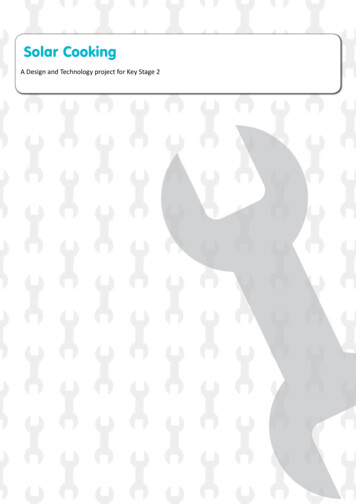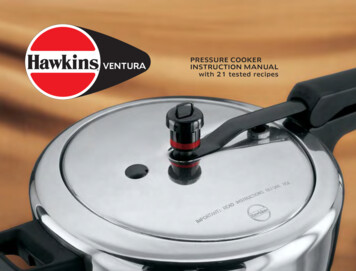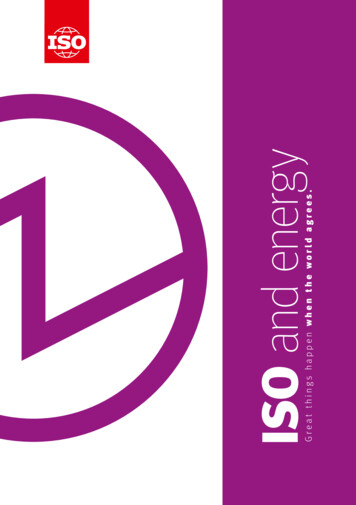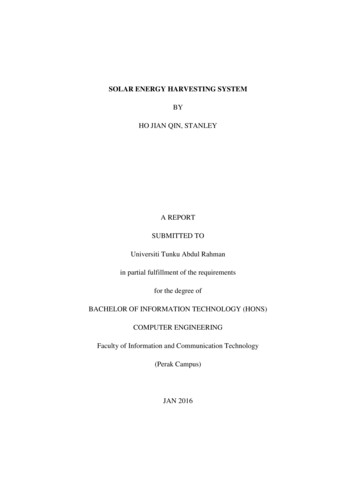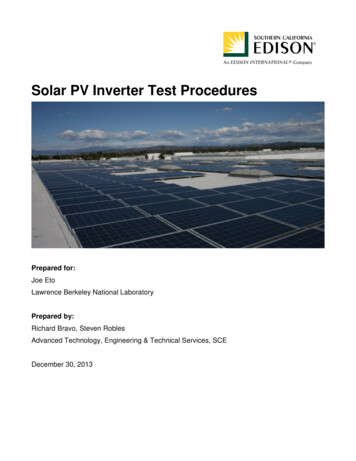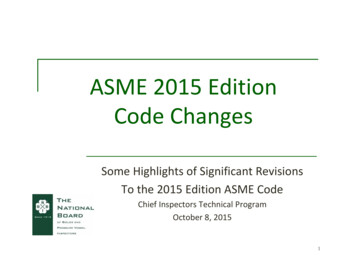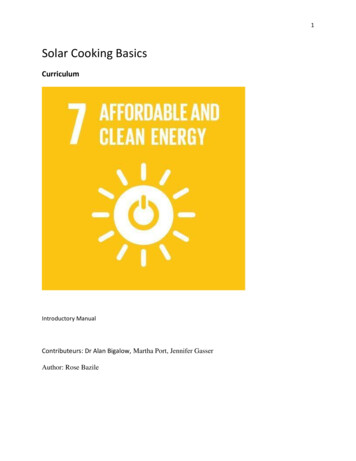
Transcription
1Solar Cooking BasicsCurriculumIntroductory ManualContributeurs: Dr Alan Bigalow, Martha Port, Jennifer GasserAuthor: Rose Bazile
2Table of ContentsA.B.C.D.E.F.G.H.I.J.IntroductionSolar Cooking BasicsThe History of Solar CookingTypes of Solar CookingWhere Is Solar Cooking Possible?Why Solar Cooking Is ImportantHealth and SafetyHow Solar Cookers WorkFollow the SunComponents of Solar Cookers1. Glazing2. Insulation3. Reflective Material4. Containers for Solar CookingK. Build a Solar OvenL. Buy a Solar OvenM. Solar PotsN. Cooking InstructionsO. Solar Cooking Tips and TricksP. RecipesQ. Solar CookbooksR. Solar Cooking Frequently Asked questionsS. Data CollectionT. CO2 BalanceU. Heat StorageV. TestingW. Most Important Solar Cooking ProjectsX. Solar Cooker Group MeetupY. The Sustainable Development Objectives of the United NationsZ. Solar Cooking and Emergency PreparednessAA. Promote Solar Cooking
3IntroductionCooking food with free, decentralized and non-emitting solar energy helps break the cycle ofpoverty.Women, children and community members breathe cleaner air, save trees and soil, save moneyfor food and education, and stay safe from violence. Solar cooking improves the quality of lifeand allows you to adapt to a changing world.Up to 1.3 billion USD Total potential cash saved by reducing CO2 emissions with solar cookers.Solar cooking helps to reduce social, economic, high iron environmental costs such as blacksoot, and fossil fuel emissions that affect all human beings and all current environments .History of Solar CookingIn addition to the general information below, specific information is available for each country.To see the history of solar cooking by country, first Choose to A country .The Moreau solar heat furnace, one of the many mirrors designed to collect the warmth of thesun in a great Surface and focus it in one place to do a useful job.
4Associated Press Photo by William Hillig in 1962A strange antecedent of the current solar cooking movement is the story of what Buti andPerlin call "the MiroBurning IR "(1980, Chapter 3). The Greeks, the Romans and the Chinese allexplored the use of curved mirrors, which they said could concentrate the rays of the sun so asto detonate almost all the burning objects.It is interesting to note that the use they perceived for this aircraft was military-could theyfocus the mirror on fire, for example, on an enemy warship? Hot mirrors were also used for lessdollar purposes, such as that the lighting of altar lights and torches for sacrificial parades, butalmost no other applied use was found. The idea, which is now seen in the concentration ofsolar cooker, is today used in countless regions of the world.A more direct route to solar cooking is the result of intensive efforts to harness the sun forhorticulture. Although found in Roman times in wealthy households, it was only in the sixteenthcentury (Buti and Perlin, pp. 41) that glass became common and cheap enough to be used forhorticulture. Global travel and trade have led to the transport of tropical plants and fruits to thenorthern countries, which has led to a desire for these products, which could not be grown innorthern climates. First the Dutch and the Flemish, then the French and the English builtgreenhouses for this purpose, heated only by the sun. A substrate horticultural activityconcentrated on tropical flora and food crops, all high under glass, in huge greenhouses. UsingSouth exposure and insulation as needed, the greenhouse movement later inspired the use of"conserve random "or" rooms of sunshine" in the houses.The principle of the greenhouse, the so-called "Solar Heat Trap", was used in what is consideredthe very first attempt to use solar energy to cook. Many Scientists of the time knew the use ofglass to trap heat, but Horace de Saussure, a Franco-Swiss scientist, wondered why thisphenomenon generally understood had not led to a user's Extra N. In 1767, he built a miniaturegreenhouse with five cans of glass * One in the other, placed on a black plateau. The fruitsplaced in the deepest box cook well-and a new technology is born (Buti and Perlin, p. 55). DeSaussure continued his experimentation, using other materials, adding insulation, cooking at
5different altitudes. This European scientist, exploring solar energy almost 250 years ago, iswidely regarded as the Pre Era of the movement of solar cooking. Others followed his example,including the British Sir John Herschel and the American Samuel Pierpont Langley, who later ledthe Smithsonian, who both conducted experiments with the hot box, Precursor of today'scooking box. .A French mathematician named Augustin Mouchot, working almost a century later, was eagerto ensure that the learning of the past was not lost. He was more interested in practicalapplication than in the number of ground devices, interesting but not very useful areas thatappeared, using the newly discovered potential of the sun (whistles, watercrafts, talkingstatues, etc.). He started a search to use the energy of the sun in a sufficiently efficient way. Heboiled water for steam engines, a company that has not succeeded. His second project wasmore successful. He combined the idea of thermal trap with that of the burning mirror, creatingan efficient solar cooker from a box which later modified by the addition of reflective mirrors.Eventually he created an efficient steam engine, but it was too big to be practical. He turned tothe challenge of cooking and has developed a number of solar cookers, pumps and evenelectricity. However, his work was short-circuited by the advent of improved coal extractionmethods and, therefore, by the use of Carburant Less expensive. His work has also been caughtup by the replacement of cheap fuels, making the use of solar energy useless and thereforeinconvenient at the moment.At the end of the nineteenth century, Aubrey Eneas, an American formed the first solar energycompany. He had built a giant parabolic reflector in the Southwest of the United States. FrankShuman founded the Sun Power Company in Cairo to promote a water pumping systempowered by solar power, then a parabolic concentrator generating electricity. Other solarinnovations have followed: engines and motors, water heaters, photovoltaic lighting and evencrematoriums. However, throughout history as in Greece and in Rome progress has beenrepeatedly interrupted by fluctuations in the availability or low cost of alternative fuels.In recent decades wealth of billions has been created with polluted fuels and destroying ourplanet. The sun can provide ways to live with income of renewable energy that will give a betterfuture for our planet and health. It continues to indicate that countless previous experiences ofdecrease in fuel resources was then forced to rediscover previous knowledge about solarenergy. Hoping this new generation will practice clean energy usage for a better future. Weshould have been practicing clean renewable energy available to all human being but creatingwealth seems to be our priority.At the beginning of the years 1900, a number of Buildings designed to take advantage of solarenergy were built using the principles of the thermal trap, but they were quickly forgotten andthen resumed in the 1930s when several office buildings the double-glazed glass helps with theheat retention. The Second World War took place, but after the war, the need for housingexploded, resulting in new attempts, including solar collectors on the rooftops.
6The Solar cooking movement began seriously in the middle of the century, with some isolatedattempts to arouse an interest in technology. At the end of the years 50, Maria Telkes , MITscientist Worked on solar cooking her interest led her to build a classic built-in oven, aninsulated plywood case with an inclined top of two layers of glass and four large flaredreflectors. The design is used, in infinite variation, until today. George Praise , former director ofthe Institute of Industrial Research at the University of Denver, Colorado was also a pioneer ofthe Solar technology, including solar cooking. In the years 1950, he experimented with a modelof Parabolic Solar Cooker The name "Umbroiler" because of its structure in the form of anumbrella. He marketed the design, but it was a commercial failure for the time.After this period, the years of the second half of the 20th century show a number of individualsand groups experimenting, demonstrating the potential realizing small and large projects usingsolar cooking appliances. From 1955, a group of individuals in Phoenix organized in Associationfor Applied Solar Energy and held its first Conference: the American Solar Energy Society and itsinternational counterpart, the International Solar Energy Society. In the 70’s, the growingscarcity of fuelwood and other energy shortages coupled with the expansion of the populationin China and in India , encouraged government research on alternatives. The first seminar onsolar Cooking was organized in 1981. The oil shortage of that time was the source for study ofpotential of solar energy, with considerable experience in Europe and the United States, as wellas in Asia. The ULOG Group In Switzerland And EG Solar In Germany , and that Solar CookersInternational In the United States, originated in the years 1980.A woman from Arizona, Barbara Kerr , along with other colleagues, also has continued todevelop models of solar cookers and test their effectiveness. She experimented with variousmaterials and promoted the technology. In 1980, Barbara Kerr and a neighbor, Sherry Cole,designed a "kit" of cardboard cooker that could be largely built by a customer and that was verymuch appreciated by those who had bought one. This work of these two women has inspiredthe formation of Solar Cookers International . A few years later, the organization, again with thetechnical assistance of Barbara Kerr, was the first to introduce another type of cookingapparatus, the panel cooker, a hybrid between the box and the parabolic. This invention was adecisive step forward because it was less expensive. Now solar cookers are affordable to meetthe needs of the poorest inhabitants of the world.It could be said that the foundation of Solar Cookers International, On July 11, 1987, was thebeginning of an effort to connect the promoters of solar cooking everywhere in the sense ofnetworking, because its intention was largely educational and networking. Coincidentally, theUnited Nations has declared that day the world's population had reached five billion people(only 13 years after reaching 4 billion). The new organization said that at least one billionpeople could benefit from knowing how to cook with the sun. Obviously, the organization hasbeen forced to steadily increase its targets, while the world's population has continued to growat more than six billion in 2004, which means that today the target group exceeds the twoMilliards.
7It is interesting to note that before the creation of SCI In 1987, a major demonstration of solarpowered cooking was carried out in the highlands of Bolivia, a region where Wood was alreadyRare. Two organizations, at the time Pillsbury Corporation and a non-governmentalorganization called Meals for Millions, jointly sponsored cooking demonstrations and latertaught the villagers how to build cookers with Local materials. In 1988, Pillsbury, in cooperationwith Foster Parents (now Save the Children sponsored a project similar to Guatemala . Theseprojects it appeared are one of the first nation-to-nation projects, initiating a long series ofprojects of this type worldwide, which continue to develop today.Since then, Many other organizations were created to sponsor projects and promote solarcooking activity. Their work, as known by the written documentation, is detailed in thefollowing chapters. This vignette is only a small part of the story, even unknown to supportersof solar cooking, the many men and women who have glimpsed the potential of the sun to cookfood and have tried over the centuries to disseminate this knowledge oo others who canbenefit from it.Solar Cooking BasicsAccording to the Place where you live and how you cook, solar cooking can save you time,effort and fuel. It is also a fun way to prepare your meals. All foods can be cooked in a type ofsolar cooker.Solar cooking is often associated with slow cooker or slower cooking. Cooking times are usuallytwice as long as conventional cooking methods, but slower cooking also has advantages. Lesswater is used than conventional cooking and foods retain more flavor and nutrients, instead ofbeing steamed or boiled. These slow solar cookers do not need to stir food during cooking. Byplacing the solar cooker a little ahead of the current position of the sun on its passage throughthe sky, the cookers and cookers can be left unattended.The parabolic solar cooker offers another approach to solar cooking by being able to achievehigher temperatures compared to the box solar cookers and panels, but they require moreattention during cooking to avoid overheating of the food. They must be redirected to the sunevery fifteen minutes or so. This can be done automatically if they are equipped with a Solarmonitoring . They are also able to fry and grill the food, which cannot be done by the box andpanel solar cookers.For the regions of the world facing the Deforestation and limited access to Drinking water ,solar cooking turns out to be an element precious or the solution. It offers an alternativewithout Smoke or boiling water in open fires, and safe for cooking.
8Buying or Building a solar oven?Solar Cookers International Panel Solar Cooker - CooKit.If you want to try solar cooking for the first time, you may be wondering if you need to Buildyour own Solar cooker or Buy one from a manufacturer . Both options have advantages:1. Building your own solar cooker can be a fun and profitable way to start.2. Buying a solar oven is simple and YOU will often receive a higher quality solar cookerthan you could build yourself.If you want to build a cooker, go to the Construction of a solar cooker to choose a model thatsuits you. You will find information comparing the Pros and cons of each style of Solar Cooker.If you want to buy a solar cooker, see the list of manufacturers and sellers on the SCI page: Buya solar cooker . Commercial solar cookers are generally durable and efficient and offer newusers an easy way to experience solar cooking. Solar Cookers are manufactured worldwide;consider potential shipping costs when choosing a model.How Do Solar Cookers Work?Most solar cookers operate according to the basic principle: sunlight is converted to thermalenergy. Most of the Panel Solar Cookers Base and Box Solar Cookers Can reach 150 c (300 f).The captured solar radiation crosses a greenhouse enclosure containing a dark-colored pot. Byreaching the dark surface, the solar radiation is converted into heat, which is not allowed toescape the enclosure and the Temperatures are reached. The same principle is oftenencountered by drivers who return in a hot car parked in the sun.Below you will find the basic science for Panel Solar Cookers and Box Solar Cookers. Anothertype of solar cooker is a Parabolic Solar Cooker . They usually require more frequent
9reorientation to the sun, but cook more quickly at higher temperatures and can fry food.Vacuum Tube Solar Cookers use a highly insulated double-walled glass tube for the bakingchamber and do not require large reflectors.A solar cooker needs a sunny outdoor location for several hours, protection from strong windsand clean/safe cooking conditions in places where the food will be healthy. Solar Cookers donot work at night or in cloudy weather, but during the best sun conditions. Some solar cookerscan cook foods under intermittent clouds.
10 The Parabolic Solar Cookers Use a bowl-shaped reflector to concentrate the light moredirectly on the pot, usually from the bottom, and generally do not require a greenhouseto hold the heat. They can also fry and grill the elements.
11SolSource is an example of Parabolic Solar Cooker presented with a cooking utensil. Thelight is concentrated at the bottom of the pan.The institutional solar Cooking Can use many large reflectors Parabolic For general Steam andcook daily for thousands of people. Many of these systems are used in India . This example wasbuilt with the technology of Solar Bridge .Converting solar light into thermal energyIn its simplest form, light/heat conversion occurs when photons (light particles) moving throughthe light waves interact with molecules that move in a substance. Rays emitted by the sun havea lot of energy in them. When they hit the material, whether solid or liquid, all this energymakes the molecules of this matter vibrate. This activity generates heat and cook.Dark surfaces become very hot in the sun, unlike clear surfaces. Also food cooks better in Potsthat are thin, shallow, dark metal with well-fitting lids. There are many other containers thatcan also be used in a solar oven.
12Keep the HeatA glazing (transparent heat trap) around the dark pot or over the cooker opening allows thesunlight to penetrate and prevents the heat from escaping. The glazing is resistant to heat, forexample, oven bag, inverted bowl, sheet of glass, sheet of plastic, etc.Sun rays pass through the glazing into the cooking chamber (solar cooker) via relatively shortwavelengths. The sun ray is absorbed by the dark colors of the pots and converted to a heat raywhich has a longer wavelength and does not easily escape out of the cooking chamber. Thisexplains why cars left in the sun, especially those with a dark interior, will become very hoteven on days when the temperature is low.Parabolic Solar Cookers do not usually require a thermal trap, as the reflector's light is tightlyconcentrated on the pot. They bake at higher temperatures, but require more frequentreorientation with the Sun than box or panel solar cookersCapturing additional solar energyShiny surfaces (reflectors) reflect the extra sunlight on the pot, increasing its thermal potential.Mirrors, aluminum foil, Mylar, mirror-finish metals, chrome-plated vinyl and other shinymaterials have all been used with success for solar cooking, depending on the type of cookerand the environment in which it will be used.Types of Solar CookersThe most common types of solar cooker are:Panel Solar Cookers, Box Solar Cookers, and Parabolic Solar Cookers. Hundreds or eventhousands of variants of these basic types exist. PANEL, BOX, PARABOLIC, VACUUM TUBES,In addition, several large-scale solar cooking systems have been developed to meet theinstitutional use in places around the world: INSTITUTIONAL SOLAR COOKERS
13Box Solar CookersALL American Sun Oven stove SolarBox Solar Cookers cook food at moderate to high temperatures and often accept more thanone pot. They usually cook food of many varieties between one and three hours of time. Allover the world, they are the most common. There are several hundred thousand in India only.Panel Solar CookersCooKit Cooker panelRoche Cooker – other MODELSPanel Solar Cookers incorporate box and parabolic concentrator units. They are simple andrelatively inexpensive to buy or produce. The Cookit Of Solar cookers International is the solarcooker most used.
14Parabolic StovesCOUPLE OF OTHER MODELSThe Cooker Dish AlSol 14 Shows how the pan is supported to receive the light focused from thebottom of the reflector.The parabolic solar cooker uses a bowl-shaped reflector to concentrate light more directly onthe pot, usually from the bottom, and generally does not require Greenhouse to hold the heat.The parabolic name refers to the shape of the curve of the reflector section.They require a more frequent reorientation to the sun, possibly every 10 minutes, but theybake more rapidly food at higher temperatures than other solar cookers, often reaching morethan 200 c (400 f). They also have the ability to fry food. In general, parabolic solar cookerswill have to be stirred more than box or panel solar cookers to avoid burning food at thebottom of the pot. They are particularly useful for large-scale institutional cuisine.Vacuum Tube Solar CookersSLiCK SM70
15Vacuum Tube Solar Cookers use a double glass tube wall for the baking chamber. The spacebetween the glasses is created in the form of a vacuum, offering excellent heat retention.Although vacuum tubes are effective, glass technology somewhat limits the size of the glasstube opening.Solar Cooking Tips and Tricks . . .Main Article: Cooking instructions and tipsThe golden rule for solar cooking is to prepare your food early and not worry about overcooking for boxand panel solar cookers. Most people who start solar cooking will use a panel solar panel cooker or abox solar cooker. These solar cookers are sun-oriented and generally do not need to be turned to followthe sun during a period of solar cooking for 3 to 4 hours. Less water is added to the recipes than bakingwith more conventional ovens.Once you have chosen a cooker, you will need to find suitable cookware. The enameled metal pans(thin-walled) work well. They warm up quickly. Cast iron pans also work and are usually preheated in thesolar oven before cooking. The advantage of heavier pots is that they will help maintain a regularcooking temperature if the sun is sometimes blocked by clouds. Many solar cooks use the enamel pots.Because dark pots work best in the solar cooker, it is important to remember to use a non-toxic paint forthe outer surface of the pot if you choose to paint your own pots.Pots for Solar CookingThe best pots for solar cooking are those made of thin and dark metal with a lid. Most timeswhen people have trouble cooking in a solar oven, we often find that they use pans in finishesthat reflected the sunlight away from the pot instead of absorbing it. Unless you are cookingwith a parabolic solar oven where the light is focused on the bottom of the pot, it is veryimportant to use dark colored pots that absorb the sunlight and turn it into heat.Light colored pots can also work but generally do not work as well as dark colored. The pot lidscan be dark or clear. Dark lids are better if your food to be cooked is light colored.
16It is important to always cook with the lid in place so that the moisture of the food does notescape and condense on the plastic bag or other Glazing.The material from which the pot is manufactured will also affect the speed with which it willwarm up and its ability to retain the heat. Here are a few things to keep in mind: Pots made of thin materials heat faster than thicker potsMetal pots heat faster than ceramics or earthenwareCeramics and earthenware are slow to heat initially, but will hold the heat better thanthe thinner metals. The cast iron should only be used in good solar cooking conditions asit requires strong sunshine to obtain the best results.It is generally not recommended to use a sheet to wrap food in solar cooking; however,temporary pots or lids can be formed from a painted (non-toxic paint) layer in the absence ofother equipment. Foods packaged in a conventional way under unpainted aluminum foil bakevery slowly. if not at all, because the glossy film, especially in several layers, insulates the foodfrom sunlight and warmth. The food won’t cook.Glass JarsSolar cooking food in jars to put in solar ovensSolar Cooking with glass jarsGlass jars make good pots although they cook better if they are darkened rather than left clear.In addition, the darkening of the outside of the food containers will protect some of the Bvitamins. When you Paint Jars , you can apply a strip of tape from top to bottom beforepainting. When the paint is dry remove the tape to leave a transparent strip of glass clean forvisual inspection to the inside of the jar.
17When you use jars for baking, make a hole in the lid of any canned jar, such as mayonnaise jars,peanut butter jars, etc., to prevent steam buildup. Be careful! Non vented jars can explode!Earthenware PotsSome clay pots with slow cooking does not cook well at first, although dark-coloredearthenware pots that are wood fired and/or have glazing, work very well. Perhaps the poorperformance of some earthenware is due to the fact that liquids are soaked into theearthenware and can evaporate outside. Perhaps it is due to the thickness and porous nature ofthe poorly cooked terracotta walls. Unglazed earthenware pots can be saturated with food oil,grease or natural resin that closes the pores and changes the surface. The oil will heat well andthis could be part of what improves cooking in low-cooking terracotta pots. The Light-coloredterracotta must be darkened outside only, perhaps by rubbing a black food, a non-toxic blackpowder or soot from clean wood in the oil layer. Despite this, some forms of low-fire terracottacan be difficult to use for some solar box cookers.Reflector MaterialAluminum foilStandard kitchen aluminum foil can work well as Reflective material for solar cooking. It can bestuck with white paste or Wheat dough. Some folds may result from the bonding process. Inaddition, although the surface of the aluminum foil is not hot to touch in the sun, there will bedifferences in the rate of expansion between the sheet and the material unto which it is glued.This can cause wrinkles. As a general rule, a slight folding of the sheet does not create aproblem for cooking.Solar cooker design continues to evolve and offers better cooking efficiency. There is anincreased interest in finding more low cost reflective materials in order to better reorient thesunlight. Polished Metal surfaces have been tried and, although effective, tend to be costlysolutions. Metallized polyester Film properly glued to plastic Coroplast sheets are an even more
18economical approach for users who want to create their own reflectors. Michelle Dean ,professor and researcher in solar energy at Brazil , explains one of these approaches in theRealization of the petals of the solar cooker with Mylar and D.Components of Solar CookersGlazingTwo transparent Pyrex bowls can be assembled to enclose the pot, creating an effectivegreenhouse enclosure.Two Pyrex bowls, or one with a Pyrex tray, are an excellent greenhouse enclosure for PanelSolar Cookers . This example worked well, even without a cover on the Porcelain cooking bowl.
19Glazing is the term used in this article and in the solar industry to describe the glass or plasticcoatings used in a cooker or solar collector. (In other industries, glazing may concern only glassproducts.)The glazing creates a Greenhouse effect "trapping" solar energy and increases the efficiency ofcooking.Glazing partially blocks the sunlight, but the overall efficiency of solar cooking increases with use ofglazing, especially in windy weather. Thicker glazing blocks usually more sunlight than the thin. Intheory and in most situations, two layers of glazing work better than one in most solar cookingapplications. A single layer of glazing will perform and is much simpler to construct.Pyrex bowls (of assorted sizes) are transparent and work well as a glazing. There is little refractionof the light, because the rays can penetrate directly unto the black pots. In 2018, Alan Bigelow ,Scientific Director of SCI , led the protocol test PEP on the solar panel cooker CooKit , comparingtwo types of greenhouse enclosures. Alan found that the use of the double-hulled Pyrex enclosurewas 25% more effective in generating heat than the use of a Plastic Roasting Bag . Moreinformation.John Roche, retired 3M research and design engineer and solar expert, states that theeffectiveness of the sun is reduced approximately 15% for every layer of glazing.Sport solar ovenAcrylic has good uv stability for use in the sunshine. It also has lower softening and meltingtemperatures. The Sport solar oven adds a sheet of UV stabilized polyester to the moldedacrylic lid to provide for excellent insulation for the oven.Plastic oven roasting bags have been widely used to create a greenhouse enclosure for the PanelSolar Cookers. However, they are much less effective than the Pyrex bowl approach. Theiradvantages include, inexpensive to buy and easy to use. They are also difficult to clean if they arecontaminated with spilled food, especially in areas where the water supply is limited. There is aproblem of removing plastic bags, which do not decompose when discarded.The cumulative cost of continuously replacing plastic oven roasting bags is more costly than aPyrex bowl and/or some commercial solar cooker models that can last for 10 years. The averagelife of oven roasting bags of fifteen uses was previously documented by SCI.
20Are plastic bags always harmful to the environment when they are not burned?ConsiderationsDifferent aspects of a ' greenhouse ' must be taken into account. Take these points into account:1. Proposed design: Cooker, hotplate or dish? A box cooker is normally closed with a glass lid.The parabolic solar cookers sometimes operate without glazings, but the glazing improvesthe performance considerably. The panel solar cookers are well served by domes.2. Material: Glass can withstand high temperatures, not all plastics can.3. Size: Does the intended pan fit in the glazing without touching the sides? How easy can theglazing be stored? A plastic bag can be bent, the glass cannot.4. Availability: If you want to build more stoves or replace a damaged solar cooker, can theglazing be easily obtained?5. Cost: Always a challenge. Solar cooking and a small budget go together for wide spreadacceptance.6. Robustness: Glass can break when used, transported or stored. Plastic is more flexible thanglass. High temperature oven roasting bags are a practical product. In Refugee situations, itcan be difficult to get water to wash the bags if food has spread over them. Long term use
3 Introduction Cooking food with free, decentralized and non-emitting solar energy helps break the cycle of poverty. Women, children and community mem
